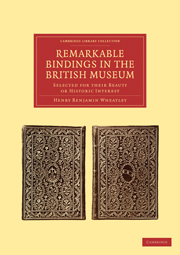Book contents
- Frontmatter
- PREFACE
- Contents
- INTRODUCTION
- I DEPARTMENT OF MANUSCRIPTS
- II DEPARTMENT OF MANUSCRIPTS
- III DEPARTMENTS OF MANUSCRIPTS AND PRINTED BOOKS
- IV DEPARTMENT OF PRINTED BOOKS
- V DEPARTMENT OF PRINTED BOOKS
- VI DEPARTMENT OF PRINTED BOOKS
- VII DEPARTMENT OF PRINTED BOOKS
- TABLE
- BOOKBINDING CONSIDERED AS A FINE ART, MECHANICAL ART, AND MANUFACTURE
- PREFACE
- CONTENTS
- HISTORY OF BOOKBINDING
- BINDING AS A FINE ART
- BINDING AS A MECHANICAL ART
- BINDING AS A MANUFACTURE
- PRACTICAL POINTS CONNECTED WITH BINDING
- APPENDIX
- DISCUSSION
- CATALOGUE OF SPECIMENS OF BINDING LENT FOR EXHIBITION
- LIST OF ENGRAVINGS
- Plate section
- Plate section
- Plate section
BINDING AS A MANUFACTURE
Published online by Cambridge University Press: 05 March 2012
- Frontmatter
- PREFACE
- Contents
- INTRODUCTION
- I DEPARTMENT OF MANUSCRIPTS
- II DEPARTMENT OF MANUSCRIPTS
- III DEPARTMENTS OF MANUSCRIPTS AND PRINTED BOOKS
- IV DEPARTMENT OF PRINTED BOOKS
- V DEPARTMENT OF PRINTED BOOKS
- VI DEPARTMENT OF PRINTED BOOKS
- VII DEPARTMENT OF PRINTED BOOKS
- TABLE
- BOOKBINDING CONSIDERED AS A FINE ART, MECHANICAL ART, AND MANUFACTURE
- PREFACE
- CONTENTS
- HISTORY OF BOOKBINDING
- BINDING AS A FINE ART
- BINDING AS A MECHANICAL ART
- BINDING AS A MANUFACTURE
- PRACTICAL POINTS CONNECTED WITH BINDING
- APPENDIX
- DISCUSSION
- CATALOGUE OF SPECIMENS OF BINDING LENT FOR EXHIBITION
- LIST OF ENGRAVINGS
- Plate section
- Plate section
- Plate section
Summary
We now come to the last division of the subject in which Bookbinding is considered as a manufacture. Books have always been issued by the publishers in some sort of cheap binding, prepared in a wholesale manner. The material used has varied at different times, but up to the middle of the last century this was usually some common leather. Paper boards had a long period of popularity until they were displaced by cloth. I have seen the old-fashioned boards described as ugly, but I do not think that is a fair expression, as a well preserved book in this binding is very pleasant to the eye of the bibliophile, and its chief fault is want of durability. When prepared calico was first found to be useful for the binding of books, a mighty revolution was inaugurated, and it is upon this branch of the trade that the improvements in machinery have chiefly been brought to bear. About the year 1825 cloth binding was first introduced by Archibald Leighton, but it was several years before its value became generally known. In the “Bookbinders' Manual,” 1829, to which I have already referred, there is a casual reference to the new style.
“Some boarded books, instead of a different coloured slip of paper, have their backs strengthened by a piece of fine canvas, which must be put on precisely as the paper above mentioned. There is another method of boarding greatly superior; the backs, instead of being sewn on bands, are sewn on strips of parchment, and the whole book is covered with canvas.”
- Type
- Chapter
- Information
- Remarkable Bindings in the British MuseumSelected for their Beauty or Historic Interest, pp. 165 - 166Publisher: Cambridge University PressPrint publication year: 2010First published in: 1889



